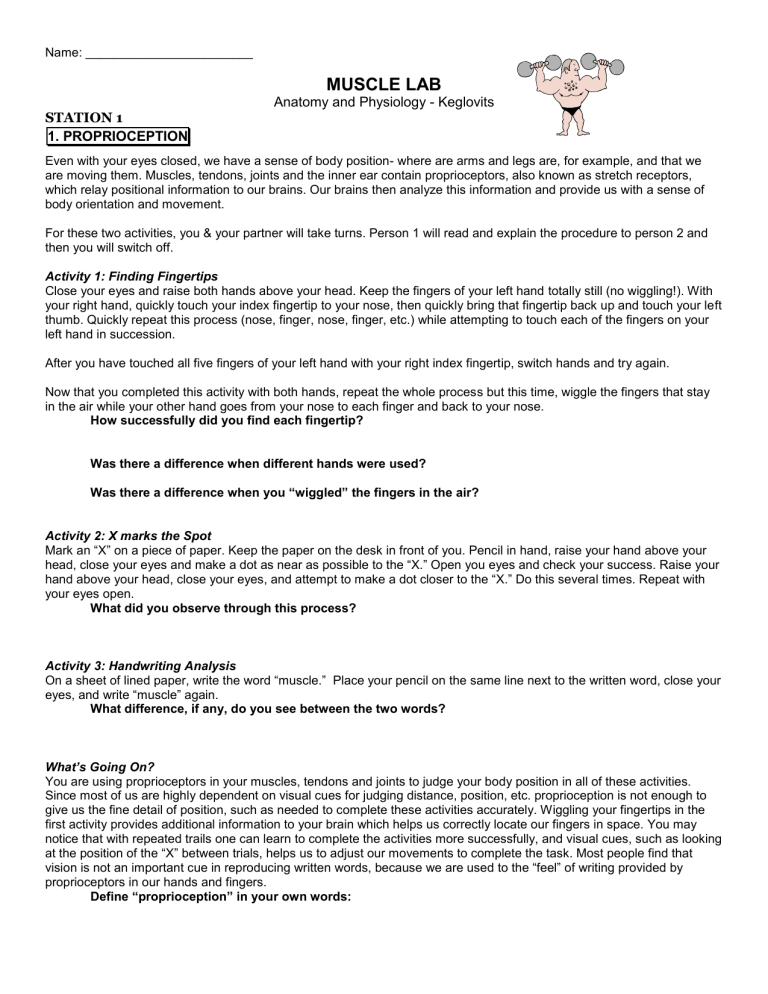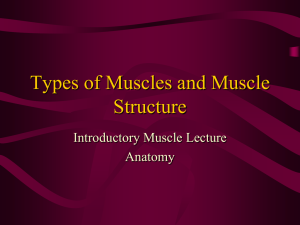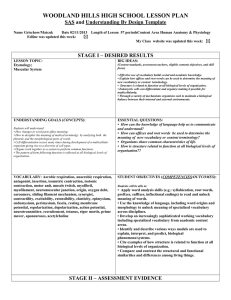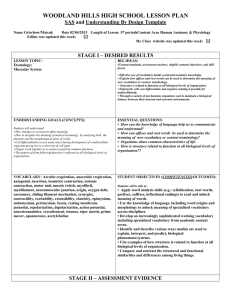muscle lab
advertisement

Name: ________________________ MUSCLE LAB Anatomy and Physiology - Keglovits STATION 1 1. PROPRIOCEPTION Even with your eyes closed, we have a sense of body position- where are arms and legs are, for example, and that we are moving them. Muscles, tendons, joints and the inner ear contain proprioceptors, also known as stretch receptors, which relay positional information to our brains. Our brains then analyze this information and provide us with a sense of body orientation and movement. For these two activities, you & your partner will take turns. Person 1 will read and explain the procedure to person 2 and then you will switch off. Activity 1: Finding Fingertips Close your eyes and raise both hands above your head. Keep the fingers of your left hand totally still (no wiggling!). With your right hand, quickly touch your index fingertip to your nose, then quickly bring that fingertip back up and touch your left thumb. Quickly repeat this process (nose, finger, nose, finger, etc.) while attempting to touch each of the fingers on your left hand in succession. After you have touched all five fingers of your left hand with your right index fingertip, switch hands and try again. Now that you completed this activity with both hands, repeat the whole process but this time, wiggle the fingers that stay in the air while your other hand goes from your nose to each finger and back to your nose. How successfully did you find each fingertip? Was there a difference when different hands were used? Was there a difference when you “wiggled” the fingers in the air? Activity 2: X marks the Spot Mark an “X” on a piece of paper. Keep the paper on the desk in front of you. Pencil in hand, raise your hand above your head, close your eyes and make a dot as near as possible to the “X.” Open you eyes and check your success. Raise your hand above your head, close your eyes, and attempt to make a dot closer to the “X.” Do this several times. Repeat with your eyes open. What did you observe through this process? Activity 3: Handwriting Analysis On a sheet of lined paper, write the word “muscle.” Place your pencil on the same line next to the written word, close your eyes, and write “muscle” again. What difference, if any, do you see between the two words? What’s Going On? You are using proprioceptors in your muscles, tendons and joints to judge your body position in all of these activities. Since most of us are highly dependent on visual cues for judging distance, position, etc. proprioception is not enough to give us the fine detail of position, such as needed to complete these activities accurately. Wiggling your fingertips in the first activity provides additional information to your brain which helps us correctly locate our fingers in space. You may notice that with repeated trails one can learn to complete the activities more successfully, and visual cues, such as looking at the position of the “X” between trials, helps us to adjust our movements to complete the task. Most people find that vision is not an important cue in reproducing written words, because we are used to the “feel” of writing provided by proprioceptors in our hands and fingers. Define “proprioception” in your own words: STATION 2------------------------------------------------------------------------------------------------------------2. OBSERVATIONS OF YOUR MUSCLES Activity 1: Muscle Action Place your fingers along the angle of your jaw just in front of your ear. Grit your teeth and observe what happens to your muscles when they contract. 1) What do you observe? With the thumb and little finger of one hand, span the opposite arm’s biceps (front muscle of the upper arm) from the elbow to as close to the shoulder as possible. Bend the arm and observe the change in the length of the muscle. 2) What do you observe? Wrap a strip of paper around your relaxed upper arm and mark the circumference on the paper. Length: _____ Clench your fist tightly and mark the new circumference on the paper. Length: _____ 3) What do you observe? What is the difference as measured in centimeters? Activity 2: Tonus The muscles of the body are normally in a state of continual and mild contraction. This is known as muscle tone or tonus, and can be detected by feeling a slight rigidity of the muscle. Palpate muscles (feel or massage) in the different regions of your body to detect the presence of tonus. Tonus is concerned with the maintenance of body posture. While sitting erect, relax the abdominal muscles. 4) What is the effect on posture of voluntarily relaxing these muscles? Next, observe the position of the mandible when it is allowed to fully relax. Hint: What usually happens to your mouth when you fall asleep while sitting up? 5) When the mandible is fully relaxed, what is its position? 6) Explain how tonus is concerned with the posture of the jaw when one is conscious and alert? 7) When do you think tonus is normally at a minimum? Activity 3: Isotonic and Isometric Contractions 8a) Explain what isotonic contractions and isometric contractions are. Give two examples for each type of contraction. 9) What is the advantage of isometric exercise? 10a) What is the main advantage of isotonic contractions? 10b) What impact does it have on cardiac and skeletal musculature? STATION 3----------------------------------------------------------------------------------------------------------------------------Activity 4: Fatigue Fatigue is a state of loss of excitability of a muscle or a group of muscles. Physiologists also recognize psychological fatigue. Holding a heavy object can induce fatigue. Your textbook will be a perfect tool to help illustrate this concept! This is a timed exercise so have your partner get the stopwatch ready. Grasp your textbook between the fingers and thumb (fingers should be superior to the thumb; thumb should be inferior to the fingers). Extend the arm laterally (START TIME) and as soon as your arm sinks half way down, STOP the time. 11) How long were you able to keep your arm holding the textbook extended? 12a) If a tourniquet was placed on your upper arm prior to the activity, how do you suppose depletion of the blood supply would affect your endurance? WHY? 13) Indicate two factors which can contribute to fatigue and how do they contribute? Activity 5: Effect of Fatigue on Muscle Action Open and close a clothespin with your thumb and index finger for 10 trials, each trial lasting 20 seconds. Perform each trial in quick succession without taking a break or rest. Record your trials in order below. 14) What effect did fatigue muscles? TRIAL 1 2 3 4 5 6 7 8 9 10 # closures / 20 sec. have on the action of your hand STATION 4-----------------------------------------------------------------------------------------------------------------Activity 6: Muscle Sounds Some muscle, such as the masseter (cheek) and the biceps bronchii, emit detectable sounds on contraction. These sounds can be heard in a perfectly quiet area (step just outside the room) when a stethoscope is placed over the area of the muscle. The stethoscope can be placed over the side of the face at about the region of the third molar (last tooth). You may also use the biceps of the anterior portion of the upper arm. Place the stethoscope on your upper arm where the muscle forms a bulge as you flex your arm. Each student should attempt this observation, taking note of the frequency of the sounds and whether or not the quality of the sound changes as these muscles are intensely contracted. 15) Describe what it sounds like to you. 16) Did you notice any difference in the sounds made by the cheek muscle compared to the biceps? 17) Explain why sounds are made when muscles contract. STATION 5------------------------------------------------------------------------------------------------------------------------------Activity 7: Cool! Stand in the doorjamb and stand straight. Abduct your arms until they hit each side of the doorjamb. Push with both arms as firmly as you can for 1 minute. Immediately after the time has elapsed, step into the classroom and consciously relax. THIS EXPERIMENT WILL NOT WORK IF YOU CONSCIOUSLY OVERRIDE THE EFFECTS OF THE ARM AT COMPLETE REST! 18) What happened when you stepped into the room and relaxed? Why? Lay supine on a yoga mat and close your eyes. Have your partner lift you legs up and hold them still for 2 minutes. Completely relax. After 2 minutes, with eyes closed, have your partner lower your feet very slowly to the ground. 19) Did it feel like your legs were falling through the floor? Why? Try it with your arms. Lay prone with your arms stretched up and eyes closed. Have your partner lift them high (but not painfully) for 1 minute, and slowly lower them to the floor. Did you feel the same sensation? STATION 6-----------------------------------------------------------------------------------------------------------------------------Activity 8: Effect of Temperature on Muscle Action Count the number of times you can make a fist in 20 seconds. Start with your hand completely outstretched and make a tight fist each time. Do it as rapidly as you can. Record the count here: _______ Now submerge your hand in a bucket of ice water and leave it there for one full minute. Remove your hand and immediately count how many forceful fists you can make in 20 seconds. Record: _____ 20) What conclusions can you draw?







